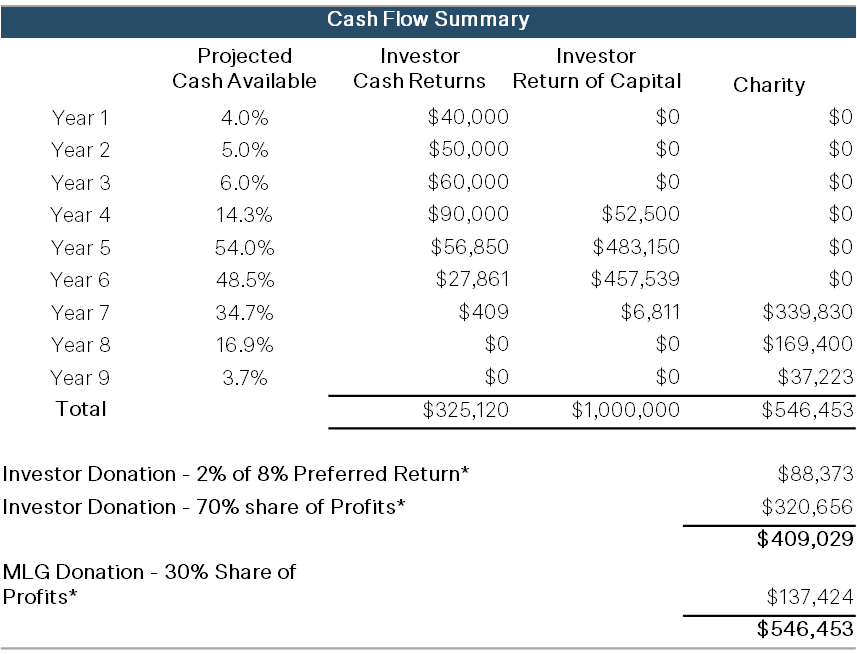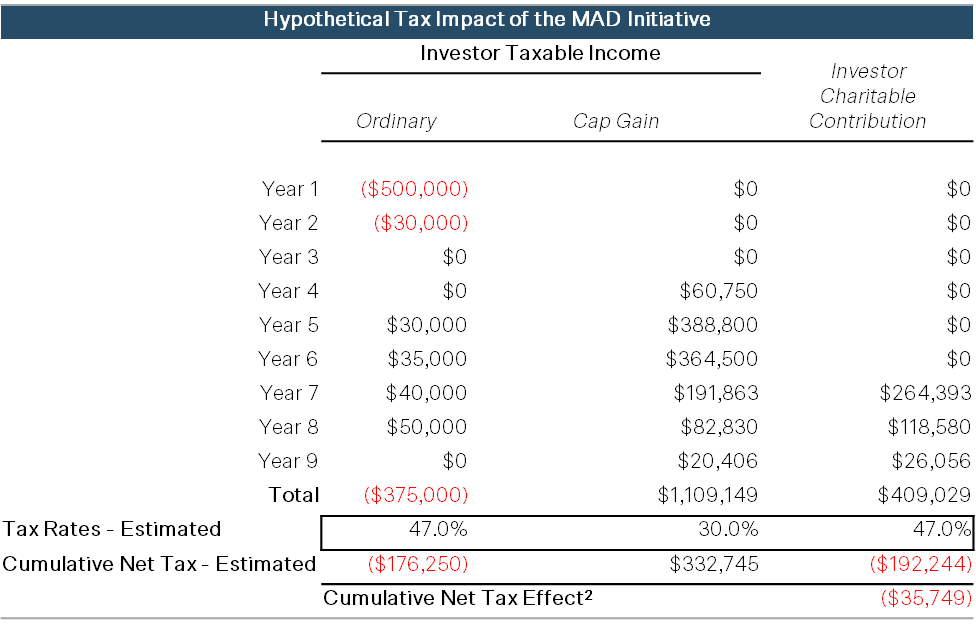Now that we’ve provided a high-level overview of the Making a Difference (MAD) Initiative, let’s take a deeper dive into how we’ve structured this investment.
There aren’t many investments out there that generate a positive return on your investment while targeting to create incredible tax-efficiency for investors. The driving force behind the creation of the MAD Initiative was not to create a tax haven but to foster rippling social impact. Needless to say, the tax benefits are indeed a bonus of the investment.
At MLG, we are value-add investors. This means we are hunting for, and investing in, assets with existing inefficiencies. We do so with the plan to resolve issues and streamline efficiencies, ultimately aiming to increase the net income the asset produces. MLG generally targets an 11-15% IRR return to investors. This is comprised of an annual 8% cumulative preferred return and share of appreciation over time. The standard share of profit is 70/30 (investor/MLG).
So, how does the math work out for an investment in the MAD Initiative?
There are two main components driving the tax efficiency within the MAD Initiative. The first stems from the passive losses generated for investors through bonus depreciation from our private real estate investments. The second is through the tax benefits generated from making a charitable donation to a 501(c)(3) non-profit organization.
Structure Case Study
Let’s use an example of the lifecycle of a $1 million investment.
An investment will receive cash returns from the cash flow of the real estate assets in the fund, as well as capital gains from the profitable sale of real estate assets in the fund. Our strategies generally anticipate an initial 4% return, growing over time. With our $1 million investment example, this equates to receiving $40,000 of cash flow in Year 1.
Our target is to increase operational cash flow, year-over-year, as we execute business plans for each asset, removing inefficiencies and ultimately increasing the net income each asset produces. In this example, we’re projecting cash flow growing from 4% to 6%, between years 1 and 3.
Typically, once we’ve maximized the potential value of a real estate asset owned in the fund, we sell the asset. We anticipate the first sale could occur in Year 4.
Within the MAD Initiative, there is a cumulative preferred return (pref) of 6%, slightly less than the 8% normally found in our series of Private Funds. This means that investors accrue a 6% return on their invested capital, annually. If the cash distribution in any given year falls short of the 6% target, the balance is accrued until it can be paid out in future years. The additional 2% will be redistributed to the organization on the back end of the investment, alongside the profit share.
By Year 4, this theoretical investor has accrued $30,000 of unpaid pref. The profits from the sale of real estate assets in Year 4 could then bring the investor current on any unpaid pref balance.
The cash flow in excess of the accrued pref can then become “return of original capital.” In Years 4, 5 and 6, the plan is for investors to see the bulk of their capital returned through property sales. Any delay in property sales will delay the return of capital. All along the way, investors are still accruing the 6% pref based on the remaining capital invested in the deal. For example, if the first $52,500 of capital is returned by the end of Year 4, in Year 5, the investor will accrue pref based on the remaining ±$950,000 still invested.
In Year 7, something fun potentially happens. With planned property sales, Investors should have received all of their accrued preferred return, and a full return of 100% of original invested capital. At this point, all the additional cash flow (profits) that would have flowed to the investors and MLG on a 70/30 (investor/MLG) split respectively, now flows 100% to the indicated nonprofit organization. Yes, both the investors’ profits over a 6% return, and MLG’s 30% share of profits go to the charitable cause!
This will continue for the life of the Fund and until the last asset remaining in the Fund is sold. We are conservatively projecting that a $1M investment will earn over $325,000 in preferred returns within 6-7 years, a return of the original investment to the investor, while also projecting to produce over $546,000 in donations to the nonprofit.

Tax Advantages
Now, let’s consider the taxes. If you remember, we aim to receive positive cash flow from operations and then send that cash flow to investors.
Between current tax law and the various tax strategies we leverage, we are typically able to create a tax loss of about 50% of the initial investment amount for our investors in Year 1 of the investment. So, in the case of our $1 million example, that estimates to a $500,000 tax loss. These losses may impact an investor’s overall portfolio, so always consult your CPA!. These losses could also play into future cash flow sent from the fund. Each individual’s tax situation is different, so you must consult with your CPA to verify these projected results.
While the bulk of the losses are produced in the first year of the investment, there could be additional losses produced in Year 2 as well. As the Fund advances in time and we execute on our business plan, assets mature and are eventually sold over time. As assets sell, cash flow will continue to be categorized as either ordinary or capital gain income to investors.
Year 7 is where it’s projected for cash flow to begin for the nonprofit. This should continue throughout the life of the Fund.
Assuming an investor is taxed at the highest federal and state ordinary tax rate of 47% combined, he or she is estimated to have cumulative net ordinary tax of ($176,250). Also, assuming the highest combined federal and state capital gain tax rate of 30%, it is estimated the total capital gains tax due would be about $332,745.
With the investor making charitable contributions, it’s important to note here that we are assuming the investor is not subject to any federal or state charitable deduction limitations and has other sources of ordinary income that can be offset by the charitable deductions. In this fact pattern (federal and state tax rate of 47%), the donations would generate a taxable loss of about ($192,244).

Snapshot of the math:
($176,250) Estimated Cumulative Net Tax
+$332,745 Total Capital Gains
($192,244) Charitable Deduction
($35,749) Net Tax Effect
That’s lot of numbers and a lot of technical tax terminology, even for me. I certainly am not a CPA, so I always recommend consulting your own in consideration to how this investment could benefit your tax picture.
Summary
To summarize, a $1 million investor looking to create or support great social impact causes could earn approximately a 6%, or $325,000 return on their investment and receive all their invested capital back, all in a very tax-advantaged manner. In unison with MLG donating corporate profits, this investment is estimated to generate over $546,000 in donations through the life of the investment. How remarkable!
One of our core philosophies at MLG is “Making A Difference, While Making a Living.” We certainly believe this investment opportunity is a unique vehicle that allows our investors the ability to do just that.
If you’d like to learn more about the story of the MAD Initiative, you can read more here. If you’d like to discuss the MAD Initiative with someone from our team, connect with me.
Jorjio Hopkins is a Senior Associate at MLG Capital, with a master’s in real estate and passion for service. He served for a number of years as a Marine Corps officer and as a dance lead for his high school show choir. Connect with Jorjio on LinkedIn. Or, if you’re an accredited investor, consider investing with us.
The Charity is the beneficiary of the investor/donor’s investment in the applicable MLG Private Fund and subsequent donations under the MAD Initiative. This is not, and will not be, an offering of the Charity receiving the donation. The investor/donor’s ability to use charitable contributions as deductions against other income is dependent upon applicable income tax laws as well as the investor/donor’s personal tax situation. The investor/donor should consult with his, her or its own tax advisor regarding the income tax consequences of investing in the MLG Private Funds and the MAD Initiative.


